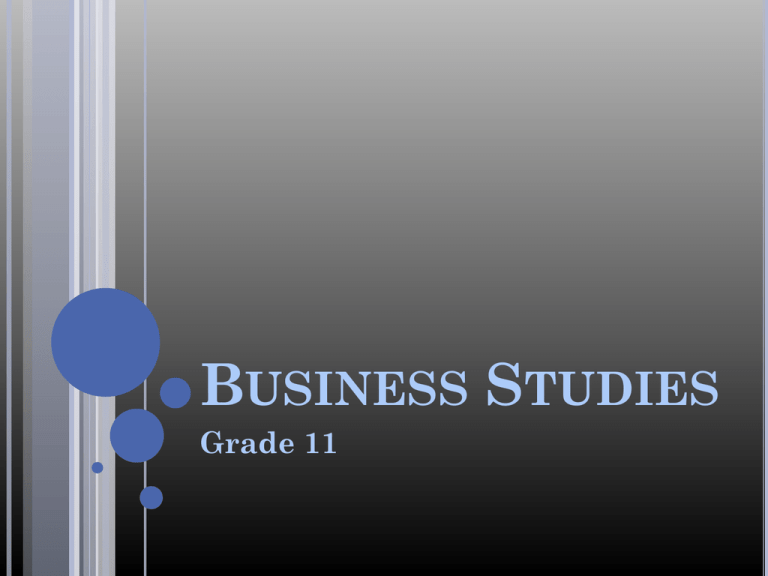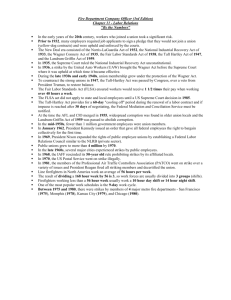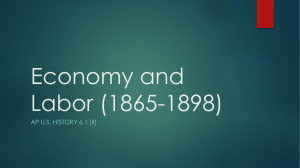
BUSINESS STUDIES
Grade 11
TERM 1
Business Environments
and Business Operations
TOPIC 4:
CONTEMPORARY SOCIOECONOMIC ISSUES
4.1 THE IMPACT OF SOCIO-ECONOMIC ISSUES
ON BUSINESS OPERATIONS AND
PRODUCTIVITY
Socio-economic issues refer to problems that affect
people (socio) and the economy (economic) of a country.
4.1.1 Income
SA has one of the highest rates of income inequality in
the world.
This is due to large differences between salaries of
high earners and low earners.
Many South Africans are battling financially due to
rising food prices, petrol prices and inflation rates.
Income inequality often leads to poverty.
Poverty causes more unemployment and skills
shortages because poor people cannot afford to pay
for educations.
4.1.1 Income
Influence on business operation and productivity
People with limited or no income cannot spend much money
Businesses can only expand if there is an increase in the
demand for their goods.
People who earn low salaries and wages may become
disheartened – this will influence productivity in a negative
way
4.1.1 Income
Possible solutions
Creation of job opportunities
Intiatives to encourage entrepreneurship
4.1.2 Inflation
Inflation refers to the general increase in the prices of
goods and services.
Inflation influences consumers because inflation
results in a reduction of buying power (money
consumers can spend).
The cost of raw materials is also affected by inflation.
This means that business enterprises must increase
prices in order to maintain reasonable profits.
Price increases can scare off consumers easily.
4.1.2 Inflation
Influence on business operation and productivity
Goods and services become more expensive.
Consumers have less money to spend.
Businesses cannot expand.
Consumers spend less and goods become more expensive due
to inflations.
This may lead to some businesses having to retrench
employees.
This has a negative effect on a country’s overall productivity.
4.1.2 Inflation
Possible solutions
Initiantives to encourage entrepreneurship.
4.1.3 Social, cultural and demographic issues
a)
Population growth:
Refers to the number of people in a country.
A population experiences growth when the number of
people who are born in a particular year.
If a population grows, the number of jobs available
must increase.
4.1.3 Social, cultural and demographic issues
a)
Population growth:
If this is not the case, a growing population can have
a negative impact on unemployment.
Crime rates are usually higher in countries with high
rates of unemployment.
A growing population demands an increase in
consumable resources such as food.
If the agricultural industry is unable to produce more
food, a nation could face starvation.
A growing population needs housing.
a)
Population growth:
This means that land must be made available for
building houses.
An increase in the number of people results in an
increase in waste products such as refuse and
sewage.
Therefore, one could say that excessive population
growth impacts negatively on employment, food
supplies, housing, pollution, infrastructure and even
crime.
Remember, if the demand for a scarce product is
high, that product is very expensive.
b)
Illiteracy:
If a person is illiterate, it means that the person
cannot read or write.
We can therefore accept that illiterate people do not
possess a proper education.
Many illiterate people cannot find work because most
jobs require some reading and writing skills.
Illiteracy impacts on business enterprises because it
is very hard to market products to people who they
cannot read.
c)
Lack of skills:
SA is currently experiencing severe skills shortages
in fields such as education, medicine, engineering
and the finance industry.
SA is also experiencing a shortage of educators –
this means that future generations will experience
skills shortage as well.
Enterprises looking to recruit candidates often
struggle to find someone with the right combination
of skills and experience.
c)
Lack of skills:
The cost of training falls on the enterprise.
Training employees is an expensive process which
impacts on productivity because it takes time for a
newly trained employee to learn the ropes of his/her
new job.
Candidates are sometimes recruited from abroad,
which is expensive and time consuming.
Sometimes, enterprises have no choice but to
appoint a candidate who lacks certain skills.
This will result in lowering an enterprise’s standards.
4.1.3 Social, cultural and demographic issues
Influence on business operations and
productivity
Possible solutions
Increase in the demand for goods and
services.
Job creation
Excessive population growth increases
umemployment, crime and pollution.
Skills
development
Difficult to market products to people
who cannot read or write.
Initiatives that
encourage
entrepreneurship
4.1.4 Economic crime
Economic crime is also known as white collar crime.
White collar crime includes the following criminal
activities:
Fraud
Fraud refers to the unauthorised use of funds.
Unauthorised means ”Wihtout permission.”
Example:
Using the business’s petrol card to fill up your own
car to go on a personal trip.
Earning money on behalf of a business without
telling the other business owners about the earnings.
Claiming more expenses on a trip that were actually
incurred.
4.1.4 Economic crime
Money laundering
Money laundering refers to hiding the source of money that
was obtained illegally.
Money can be obtained illegally in different ways for
example stealing and drug dealing.
Money that was obtained illegally is know as ”dirty money”.
Dirty money is sometimes used to run legal businesses.
He money made from legal business, then appears
”washed” or ”laundered”.
4.1.4 Economic crime
Influence on business operations and productivity
Business owners who are involved in money laundering face
criminal charges.
Loss of income if money has been stolen from a business.
Loss of jobs if a business closes down.
4.1.4 Economic crime
Possible solutions
Implement fraud prevention strategies.
Limit the number of people who have access to a business’s
money to the absolute minimum.
Identify vulnerable areas in the business.
Conduct regular internal audits.
4.1.5 Ethical misconduct
a)
Sexual harassment:
Sexual harassment in the workplace involves
unwelcome or unwanted attention of a sexual nature
from someone at work that causes discomfort,
humiliation, offence distress, and/or interferes with the
job.
Sexual harassment includes:
•
•
•
Unwelcome sexual advances
Requests for sexual favours in return for employment
benefits
Pressure for sexual favours to clinch sales deals
a)
Sexual harassment:
It is immoral, wrong and unethical to abuse your
position to take advantage of another person.
Employers should be proactive and prevent the
problem, rather than having to address it after
damages have been suffered.
b)
Corruption:
Refers to acts of dishonesty.
Involves the abuse of one’s position for dishonest gain,
like in “bribery” and “kickbacks”.
Description:
Bribery:
• Money is offered to a person to influence that person
• Example: money is offered to a traffic officer by an offender
to “forget” about a traffic offence.
Kickbacks: • Money is paid back to a person who makes a transaction
possible.
• Example: a road construction company pays some of the
money made back to the government official who awarded
the job.
c)
Mismanagement of funds:
Mismanagement of funds refers to the wrongful use of
funds that do not belong to you.
Often used in the same context as fraud.
It include inappropriate procurement procedures and
irregular expenses.
4.1.5 Ethical misconduct
Influence on business operations and productivity
Employees who have been victims of sexual harassment
will experience a lack of concentration, anxiousness and
lack of productivity.
Corruption and mismanagement of funds will lead to a
loss of income.
4.1.5 Ethical misconduct
Possible solutions
Steps that an be taken to deal with sexual harrassment
include:
Formulating a clear policy regarding sexual harassment.
Making others aware of the problem, of their own rights
and of the rights of others.
Implementing clear complaints and disciplinary
procedures.
Formulating an employment equity programme that
ensures well planned career paths that are based on
merit, for all employees.
Working in a positive corporate culture, where the rights
and dignity of all staff members are respected.
4.1.5 Ethical misconduct
Possible solutions
Corruption and mismanagement of funds:
Adopt a zero tolerance approach towards corruption.
Conduct regular internal audits.
Limit the number of people who have access to a
business’s funds.
Offer awards to whisstle-blowers.
4.1.6 Natural resources
a)
Unavailability of natural resources:
Some natural resources e.g. oil, coal, food, water and gold,
are scarce.
This means that if we do not monitor the use of natural
resources, some resources will soon be depleted.
The depletion of resources will not only impact business
enterprises, but human life in general.
SA has already experienced load shedding.
Many business enterprises have lost millions of rands
because of load shedding.
Business enterprises, as well as the population in general,
must guard against the inefficient use of natural resources,
because resources are limited.
b)
Inefficient use and exhaustion of resources:
Inefficient use of resources means that resources are
being wasted.
Businesses must devise strategies to make sure that
natural resources are used efficiently.
If resources are used inefficiently they become even
scarcer.
This will lead to an increase in the price of goods and
ultimately to the exhaustion of certain resources.
Some resources, like oil and coal, cannot be
reproduced.
The growing human population means an increasing
demand for resources – this also accelerates the
depletion of resources
4.1.6 Natural resources
Influence on business operations and productivity
Businesses cannot continue with business operations if
natural resources are depleted.
Businesses must develop and implement environmental
policies.
Loss of productibity if business operations come to a halt due
to unavailability of natural resources.
4.1.6 Natural resources
Possible solutions
Finding alternative sources of energy.
Recycling.
Finding businesses that fail to comply with environmental
laws.
Creating environmental awareness among businesses and
individuals.
4.1.7 Dumping
Dumping is when other countries dump their excess
products on the SA market to dominate the local
market.
Dumped products are usually very cheap.
Dumping has a negative influence on local businesses
because local businesses are unable to produce the
same products the same products at an equal or lower
price.
Consequently, consumers buy the dumped products.
This hurts local businesses as they are unable to sell
their products.
4.1.7 Dumping
Influence on business operations and productivity
Loss of income.
Loss of job opportunities.
Loss of productivity.
4.1.7 Dumping
Possible solutions
Intitiatives that encourage entrepreneurship.
Limit the number of imported goods.
Creating awareness among consumers about locally produced
goods through marketing.
4.1.8 Piracy
Takes place when a person makes copies of goods that
are protected by either copyright law or trade mark
laws, without the consent of the true owner of the
goods.
Products that are often associated with piracy are
computer software, CD’s and DVD’s.
Consumers create a demand of pirated goods.
If no one buys pirate goods, then criminals will have
no-one to sell pirated goods to.
4.1.8 Piracy
Definitions:
Intellectual property
Copyright
A product for example artwork, music
or poetry that was the product of
someone’s mind. Intellectual property
belongs to its creator.
Only an owner of intellectual property
has the right to produce and copy it.
Patent
An invention. Someone who holds a
patent has the sole right the sole right
to produce and sell an invention.
An unique mark that represents a
business enterprise and that belongs
to the business enterprise.
Trade mark
Includes words, slogans, designs, signs
and symbols.
Registered trademarks may not be
used by anyone other than the
business enterprise/person it belongs
to.
4.1.8 Piracy
Influence on business operations and productivity
Loss of income.
Increase in prices of authentic goods.
Loss of productivity.
4.1.8 Piracy
Possible solutions
Create awareness among consumers about the effects of
piracy on business operations.
Take action against people who produce and sell pirated
goods.
4.1.9 Strikes
A strike is usually the result of a labour dispute.
A strike takes place if workers refuse to work.
A labour dispute is a conflict of interest between
members of a trade union and their employer.
The most common reasons for strikes are wages,
working hours and working conditions.
4.1.9 Strikes
a) Different kinds of strikes:
Description:
Go-slow:
Employees show up at work, but work very slowly
and produce fewer goods than usual.
Sympathy strike:
Members of other trade unions, who are not in
dispute with their employer, join the strike to support
workers who are in dispute with their employer.
Sit-down strike:
Employees show up at work, but refuse to do any
work.
Wildcat strike:
Against the law – takes place without any warning.
Work to rule:
Workers cause a decrease in production by doing only
the minimum of what is expected of them, according
to the rules of the workplace.
Lockout:
Employees are locked out by their employer and
refused entry to their workplace.
b)
The Labour Relations Act: nature and purpose:
Makes provision for collective bargaining, e.g. during
wage disputes.
Makes provision for the settling for labour disputes.
Makes provision for trade unions and discusses the
roles and rights of trade unions.
Regulates the right to strike and to recourse to lock-out
in terns of the constitution.
Promotes employee participation in decision-making
through the establishment of workplace forums.
Provides simple procedures for the resolution of labour
disputes through conciliation, mediation, arbitration or
independent alternative dispute resolution services.
c)
What is a Trade Union?
A trade union is an employee organisation that focus
on improving working conditions.
COSATU and Solidarity is an example.
d)
History of trade unions:
The Trade Union movement originated in Great Britain.
Due to the fact that workers were uneducated and
illiterate, workers could not negotiate better terms of
employment and they did not have power to influence
their employers.
Workers realised that they have more power when they
stand together.
Workers formed trade unions to use their collective
bargaining power for negotiation better working
conditions.
Initially, trade unions were not recognised by the law
and employers did not want to deal with trade unions.
The Role of trade unions:
Improve working conditions and terms of employment.
Ensure that workers are treated fairly at work.
Strive to ensure that workers get a fair share of the
wealth generated by business enterprises.
Try to improve social security.
Achieve greater control over the management of
employment relationships.
Resolve grievances and disputes in the workplace.
Try to prevent retrenchment.
f)
Functions of trade unions:
Represent people at work.
Lobby government and other decision-makers to
ensure the best possible deal for workers.
Take part in collective bargaining processes.
Protect the rights of members in the workplace.
Negotiate equitable wages and benefits.
Support gender equality.
Provide and restructured medical aids.
4.1.9 Strikes
Influence on business operations and productivity
Loss of productivity.
Loss of income.
Can lead to the improvement of employer/employee
relationships.
4.1.9 Strikes
Possible solutions
Employers and employees must adhere to labour legislation.
Issues between members of trade unions and employers musst
be resolved before labour action takes place.





